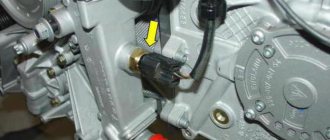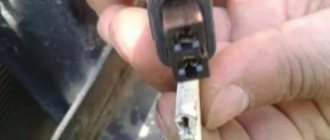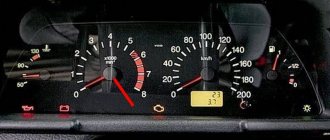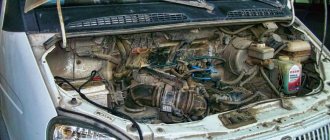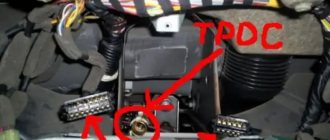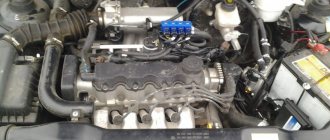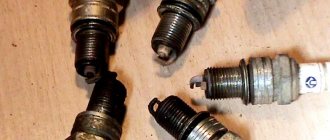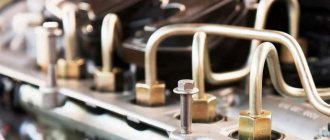More than half of motorists who choose, for example, a gazelle, switch their horses to gas. If you put a 120-liter cylinder on a long-wheelbase gazelle, the power reserve will exceed 450 km. However, when putting a gazelle on LPG, you should think about strengthening the springs. The standard five sheets may not cope with the gas-plus-gasoline combination. And the gazelle will not let you down. That is, gas-cylinder equipment, with all its advantages, requires a competent attitude.
Idling
A common phenomenon is floating idle speed when operating on gas; this occurs quite often after a recent change of injectors in the LPG system. And the fact that after replacing the injectors with new ones the car drove well for some time only confirms that this is precisely the problem. Or more precisely, the need for additional calibration of new injectors after the car has driven one to two thousand kilometers. If your problem is the unstable operation of the car at idle, after recently replacing the injectors, be sure to contact a specialist who will calibrate and configure the system.
Gas pressure - testing all theories of change
The problem of pressure on injectors does not only plague gasoline fuel supply systems. In gas equipment there is also the possibility of encountering such a nuisance. The thing is that pressure is built up in the gearbox, which tends to fail regularly. The gearbox can be repaired, but to do this you need to carry out diagnostics, buy a repair kit of spare parts and entrust the car to a specialist. It’s better not to do anything with your own hands in HBO systems. This may cause problems later on.
A trivial reason - poor quality gas or the need for maintenance
Gas equipment of the 4th generation is considered the most common today; they are trying to install it on cars with an injection system. The system contains several filters. Some manufacturers install a coarse filter in the area where the tank is installed. Also installed in the engine compartment is a small filter element for coarse cleaning, as well as a fine gas filter. They need to be changed once every 20-30 thousand kilometers or every 2-3 years. If maintenance has not been done for too long, the filters are clogged, which will cause a decrease in fuel pressure in the system.
Regarding gas quality, it is worth remembering the following:
- bad gas is sold today at every second gas station, in Russia problems with fuel quality have not gone away, and this also applies to autogas, so you should carefully choose a gas station;
- cheap and dirty gas quickly clogs filters, they lose capacity and actively reduce the quality of vehicle operation, as they do not perform their functions normally;
- poor fuel burns worse than required by a gas installation, which also causes unpleasant features in the operation of the car, power is lost, and the quality of the car’s performance deteriorates;
- consumption increases, since the driver has to constantly press the pedal in order to drive normally; under normal conditions, traction on gas and gasoline is almost the same, if there are no other breakdowns;
- at low and idle speeds the car does not understand what to do, the computer either increases or decreases the speed, trying to balance between stopping the engine and an emergency situation.
You can fill up bad gas even at a very good gas station. No one is immune from troubles that can happen with fuel. It is worth choosing one station where propane is not too cheap and also suits you in terms of quality. It is at this gas station that you should refuel in the future. Experiments with the quality of gasoline may pass without a trace, but you will immediately feel the quality of gas in your car and experience the most unpleasant emotions in operation. This is important to remember when choosing a gas station.
Sensors - look towards electronics
The second reason for a car jerking on gas is the sensor system. In the 4th generation, several sensors are installed that transmit information to the ECU or to its own computer. The set may differ in different generations and modifications. For example, there is a gas mixture pressure sensor that controls the operation of the gearbox and supplies the mixture to the injectors. It is this that often causes problems with the car twitching at idle or low speeds. This sensor is also called a MAP sensor; it often fails.
The problem algorithm develops as follows:
- one of the parts of the MAP sensor burns out, which is responsible for measuring the gas pressure in the system, and also measures the temperature in more modern installations, which is also important for normal operation;
- further operation on gas becomes arbitrary, the speed can float or stop in any position, despite the optimal travel mode and good gas filling;
- the next stage - the sensor misses the readings of the mixture temperature, which causes the supply of fuel to the injectors that is not heated to the optimal temperature, this also causes combustion problems;
- the pressure on the injectors drops to critical values, and sometimes the supply is cut off altogether, this leads to an emergency switch to gasoline and errors in the gas system sensor system;
- This damages the sensor even more, the operating parameters of gas-cylinder equipment become unclear, and you have to drive on gasoline until visiting a service station.
But the MAP sensor is not the only electronic part that causes such unpleasant operating features of the car. There are also a number of other sensors, the set of which greatly depends on the manufacturer and modification of the LPG systems. If you have a low-cost setup, you can simply replace the sensor kit. If the cost of automation is high, it’s worth going for diagnostics and finding out which parts are causing problems in your car’s system. This way you will save money on buying unnecessary parts.
Does it jerk when moving?
It often happens that a completely new and apparently intact car with gas-cylinder equipment, which starts perfectly when hot, suddenly behaves strangely when accelerating: it jerks when moving, tears, jumps at medium speeds, as if at zero. And the tank is full of fuel. And you were lucky if you didn’t have time to drive far from the gas worker while accelerating, however, according to the law of the sandwich, it usually jerks into the heat completely inopportunely - in the wilderness, or when climbing a mountain. If you switch to gasoline, the breakdown disappears.
The problem, of course, will not be resolved by itself and, in an amicable way, the car will need to be diagnosed. But there is a temptation to tinker with it yourself.
Before disassembling the gas system, make sure that the car runs smoothly on gasoline, both at idle and when hot.
Removing scratches on a car body without painting.
DON'T WASTE MONEY ON REPAINTING! Now you can remove any scratch from the body of your car in just 5 seconds.
Read more >>
The problem is not with HBO
Quite often it happens that the car jerks on the gas while driving not at all because of the gas equipment, as the driver thinks, but because of a malfunction in the electrical part of the car.
Most often, drivers identify the following problems:
- The gap in the spark plugs and their overall serviceability. It is believed that the optimal gap should be in the range of 0.7-0.9 cm, although some car enthusiasts set the gap on the spark plugs up to a value of 1.1. There are also special spark plugs for running cars on gas; they differ from regular spark plugs in their clearances and design. When a spark plug is faulty, it simply “breaks through”, as a result of which the current follows the path of least resistance.
- High voltage wires. The second most common problem is the wear and tear of the car's high-voltage wires. If your armored wires have traveled more than 80,000 km. without replacement, it is best to replace them with new ones. An experienced electrician will help identify the malfunction of one wire.
- The third most important problem is the problem with the car’s ignition coil; if there is a problem with it, the coil should be replaced with a new one.
- Gas mixture. The quality of the mixture can also have a serious impact on the car's behavior. Try changing the gas station to another.
Jerks due to ignition
Experience proves that in eight out of a dozen options, a gas-powered car jerks during acceleration not even because of the gas, but because of trivial issues with the electrics: spark plugs, high-voltage armored wires, ignition coils and electric valves.
An electrical breakdown does not necessarily recur when accelerating on gasoline or idling. It’s just that gas itself ignites worse, ignites differently and burns much slower than gasoline, which is why the gas-air mixture turns out to be more modest, even at startup, even when it’s hot. When the engine is running, the gas-air mixture requires a higher voltage to ignite - 16 kV (14 kV for gasoline). But the combustion of the gas-air mixture gives a significantly higher temperature of the combustion chamber, for this reason the wear of conventional gasoline spark plugs is accelerated many times over. Therefore, it is important to install spark plugs on gas-cylinder equipment “cooler”, that is, with a lower heat index.
The use of special spark plugs recommended for installation in a car with LPG is not a marketing ploy, but an objective necessity. Such a candle differs not only in the gap, but often also in the design. Replacing it is easy.
A lower density of the gas-air mixture, especially during acceleration, requires an increased breakdown voltage, which exposes all weak ignition links to clean water. Which is another reason to think about special spark plugs, or at least about reducing the gap yourself. Often, missing sparks occur at medium speeds, which is due to the formation of carbon deposits on the spark plugs, which is why the spark strikes when it hits. Start small, cleaning and lubricating the coil contacts is useful, and even during jerks at medium speeds, this is simply an urgent measure.
Mechanics
Over-depletion of fuel assemblies due to unaccounted air in many cases is the cause of jerks. Find out more about how to find and fix air leaks with your own hands here.
Injectors
If, after checking the electrical system, the car still starts to jerk when you press the gas pedal, the first thing you should do is inspect the fuel supply hoses to the injectors. Their length and size must be the same (max. 25cm). Bends, fractures, cracks, and gas leaks are excluded.
Let's move from simple to more complex. For further diagnostics, you will need a cord and a 4th generation HBO setup program.
First, you need to check the functionality of the electromagnetic coils of the injectors by turning them off one by one. Perhaps some coils are working intermittently. Injectors may also function with uneven fuel supply (inconsistent), reasons:
- incorrectly selected brands of injectors (by performance)
- wear due to high mileage
- clogging
- wrong nozzle diameter selected
- due to wear, rod injectors require calibration or repair/replacement
Also, shocks may appear during acceleration at low speeds (up to 2500 rpm) or a sharp start, due to the increased opening time of the injectors.
To avoid twitching when releasing the gas to idle and further accelerating, turning off auto-adaptation at the adjustment stage will help. For some cars it is simply useless.
Reducer-evaporator
Incorrect selection of the gearbox for the engine power or its malfunction, for example, destruction of the membrane (a rich mixture is obtained), will also cause failures, especially under load at high speeds.
To detect a diaphragm rupture, it is necessary to remove the vacuum hose from the suction manifold side and check it for gas leaks. In this case, the machine must run on gas fuel.
Quite often, the car jerks on gas if the evaporator does not heat up due to an incorrect connection. Setting the gearbox according to fuel pressure also affects the jerking of the car in motion.
Timely draining and washing of the evaporator reducer from condensate will help get rid of “kicks”, but this is a condition for 2nd generation LPG reducers.
Let's sum it up
Modern cars require high-quality fuel and good maintenance. If these factors of their operation are violated, problems with technical capabilities appear, the machines begin to show a variety of problems and, in general, do not want to serve. When the car jerks when driving on gas, it is not recommended to continue using the car. We need to find the reasons why transport behaves so inappropriately. After searching for the reasons, it will be possible to completely restore the HBO system and return it to normal operation. But this is only possible after a full diagnosis.
It is recommended to undergo a complete maintenance of the gas installation once every 3 years, including replacing all filters, checking sensors, setting and calibrating injectors, and overhauling the gearbox. Also in this process, the technician will search for air leaks, which may be the cause of various problems in the vehicle system with LPG. You should carefully consider the process of repairing and restoring gas equipment. Otherwise, operating the equipment will be impossible, and you will spend more and more money on gas due to increasing consumption. Have you ever experienced your car jerking at low speeds?
Source
Gearbox, hit idle
If the engine jerks at idle, then it makes sense to clean (replace) the valve and adjust the idle speed. You also need to inspect the screw on the gearbox. Due to an accidental shift, a pressure drop occurs and, as a result, jerks. If the car jerks, you will have to reconfigure the gearbox and try to achieve clarity at idle. The gearbox may not warm up as required. Then you need to evaluate the path of antifreeze for kinks and circulation.
If the issue is not resolved by tuning, then all that remains is to completely change the repair kit in the gearbox so that the idle speed no longer bothers you.
Speaking about wires, it should be noted that it is not always possible to identify their disease using the traditional method - we look at how the engine behaves in the dark. Why, if the armored wires are not “fresh”, then they also need to be replaced. If possible, it would not hurt to first measure their resistance and check for breakdowns.
Non-standard situation
Failure of the camshaft position sensor of a VAZ 2110 with an injection engine switches the internal combustion engine from distributed to pairwise-parallel injection. Accordingly, the injection time of gasoline injectors is reduced from 4.5 to 2.7. In this case, there are no fault signals (check engine).
The wire through which the LPG electronic control unit reads engine speed pulses is often connected specifically to the DPRV. When switching to gas, the controller does not receive a signal from the sensor and the car begins to twitch.
Solenoid valve
To check for a malfunction in the solenoid valve, you need to switch the car to gas and try the ignition. A good valve will click in a peculiar way. If it is peculiarly silent, then you need to inspect the contact connections and the integrity of the fuse.
It would be a good idea to clean all the filter units, because their clogging interferes with the flow, which sharply reduces the potential of the internal combustion engine, and the engine can stop completely.
A clogged filter can clog the gearbox, which leads to depressurization. It is important to be careful when cleaning filters with solvent. Perform all actions only after closing the valve on the cylinder.
Gaza Strip
Faults in gas equipment, as a rule, accumulate during operation. Mostly they relate to air leaks that occur through the connections of the entire gas equipment, in dried out or frayed hoses, in a deformed gearbox gasket, due to systematic freezing. It must be said that a good gas-air mixture is a mixture whose proportion normally corresponds to the optimal value for combustion. There should be 16.5 air per part of gas.
Otherwise, the mixture will either be thicker, increasing fuel consumption, or less often, depriving our car of its legitimate design agility and adding the notorious twitching.
With such symptoms, it would not be superfluous to check the car for tightness of the intake manifold from excess air.
Why can the VAZ 2109 carburetor twitch?
The VAZ 2109 jerks while driving for the reason that a breakdown in this VAZ may be due to the carburetor.
Reasons why the carburetor twitches:
- Fuel filter failure. This is considered the most common breakdown in the VAZ 2109. Therefore, if jerking occurs in the car, the first thing you need to do is check this particular fault.
- Another important cause could be a breakdown of the accelerator pump.
- Broken ignition distributor. The vacuum corrector in it may break. Also, in addition to this, there may be other reasons for the breakdown. To accurately determine what happened, you need to take the car to a service center for a full diagnosis.
